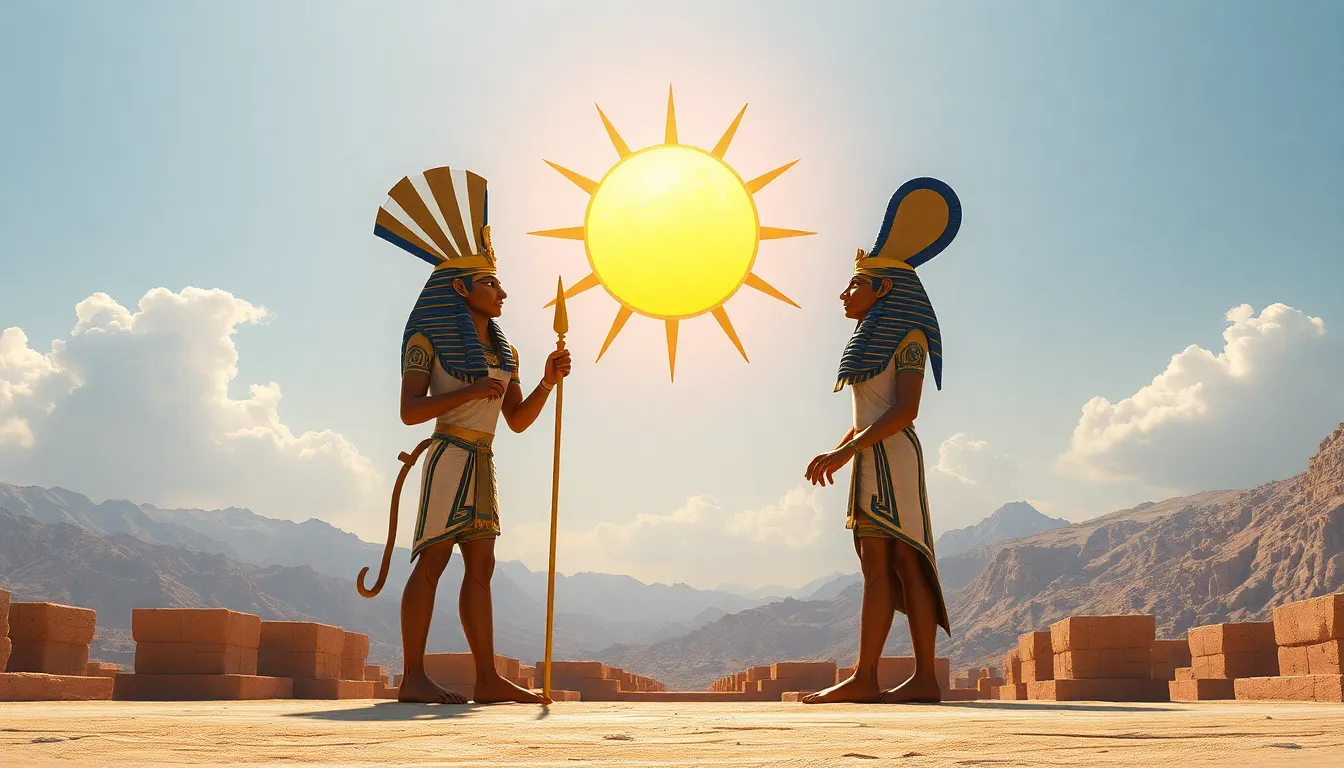Ra and the Sun: The Central Figures in Egyptian Cosmology
I. Introduction
Egyptian cosmology is a rich tapestry woven from the beliefs, myths, and spiritual practices of ancient Egypt. At the heart of this cosmology lies the sun god Ra, an essential deity whose influence permeated every aspect of life and society. The importance of Ra and the sun in ancient Egyptian beliefs cannot be overstated, as they symbolized life, renewal, and the cyclical nature of existence. This article aims to explore the multifaceted role of Ra and the sun within Egyptian mythology, their significance in rituals, and their lasting impact on culture.
II. The Mythological Origins of Ra
Ra’s origins in Egyptian mythology are steeped in creation myths that vary across different texts and regions. According to the Heliopolitan creation myth, Ra emerged from the primordial waters of Nun. He is often depicted as a falcon-headed man crowned with a sun disk, symbolizing his divine nature and association with the sun.
The various forms and aspects of Ra include:
- Khepri: The scarab god, representing the rising sun and rebirth.
- Atum: The creator god, often associated with the setting sun and the cycle of creation and destruction.
- Ra-Horakhty: A syncretic form combining Ra with Horus, embodying both solar and kingship aspects.
Ra holds a prominent position in the Egyptian pantheon, often regarded as the king of the gods. His influence extended beyond the heavens, impacting the earthly realm through his connection to the pharaohs and the natural world.
III. The Sun as a Symbol of Life and Renewal
The sun was a vital element in ancient Egyptian agriculture and daily life. It provided light, warmth, and energy necessary for the growth of crops and the sustenance of life. The Egyptians observed the sun’s cycles closely, using them to inform their agricultural practices and seasonal festivals.
Sun cycles were closely correlated with Egyptian rituals, which included:
- Celebrations of the annual flooding of the Nile, vital for agriculture.
- Festivals honoring Ra during solstices and equinoxes.
- Daily morning rituals to greet the sun’s rise.
Additionally, the sun embodies a duality in Egyptian mythology, serving as both a life-giver and a destroyer. While it provides warmth and sustenance, its intense heat can also lead to drought and death, reflecting the balance of nature.
IV. Ra’s Daily Journey Across the Sky
Ra’s journey across the sky is depicted as a daily cycle of emergence and descent. Every morning, he rises from the horizon, symbolizing hope and the renewal of life. Conversely, his descent into the underworld at night represents the inevitable cycle of death.
The symbolism of the sun’s journey is deeply intertwined with themes of death and rebirth. As Ra travels through the underworld, he battles the serpent Apep, the embodiment of chaos and destruction, ensuring the sun’s return each dawn.
The solar barque, a great boat that Ra sails in during his daily journey, is a significant symbol in this mythos. It represents:
- The journey of the soul through the afterlife.
- The connection between the divine and the mortal realms.
- The cyclical nature of existence and the promise of rebirth.
V. Temples and Worship of Ra
Major temples dedicated to Ra, such as those in Heliopolis, were central to the religious practices of ancient Egyptians. These sacred spaces served as hubs for worship and community gatherings, where rituals and offerings were made to honor the sun god.
Rituals and offerings typically included:
- Daily morning prayers to welcome Ra.
- Offerings of food, incense, and flowers.
- Festivals celebrating the solar cycles, including the Opet Festival.
The role of priests and priestesses in solar worship was crucial. They were responsible for performing rituals, maintaining temple activities, and interpreting the will of Ra. Their authority and knowledge underscored the importance of Ra in the spiritual and political life of ancient Egypt.
VI. Ra’s Connection to Pharaohs
Ra’s association with the pharaohs established the divine right of kings in ancient Egypt. Pharaohs were believed to be the earthly embodiment of the sun god, acting as intermediaries between the gods and the people.
Pharaohs often identified themselves with Ra in several ways:
- As the living Horus, they were seen as the earthly manifestation of divine authority.
- They adopted titles such as “Son of Ra,” reinforcing their connection to the sun god.
- Ra’s role in legitimizing political power was illustrated through monumental architecture and inscriptions.
VII. Cultural Legacy of Ra and Solar Worship
Ra’s influence extended beyond religious practices into art and literature. Egyptian artists depicted Ra in various forms, celebrating his power and significance through sculptures, paintings, and hieroglyphics.
The transition of solar worship into later religious beliefs can be seen in the integration of Ra into the mythology of other cultures, influencing deities in Greco-Roman traditions and beyond.
Modern interpretations of Ra continue to thrive, with many finding inspiration in his symbolism of life, renewal, and the cycles of nature. The enduring legacy of Ra remains evident in contemporary discussions of mythology and spirituality.
VIII. Conclusion
In summary, Ra’s significance in Egyptian cosmology is profound, shaping the religious, political, and cultural landscape of ancient Egypt. The sun god represents the essence of life and the cyclical nature of existence, illustrating the ancient Egyptians’ deep connection to their environment.
The continued fascination with Egyptian mythology, particularly the stories and symbolism surrounding Ra, reflects a universal human desire to understand our place in the universe. By studying these ancient beliefs, we gain insights into the values and perspectives that shaped one of history’s most enduring civilizations.
Ultimately, understanding Ra and the sun within Egyptian mythology allows us to appreciate the complexities of ancient beliefs and their relevance in contemporary culture.




